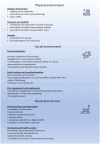Stakeholder Perspectives on Built Environmental Factors to Support Stroke Rehabilitation and Return to Everyday Life
- PMID: 40600503
- PMCID: PMC12215816
- DOI: 10.1111/hex.70339
Stakeholder Perspectives on Built Environmental Factors to Support Stroke Rehabilitation and Return to Everyday Life
Abstract
Background: The transition to undertaking rehabilitation in the home or local neighbourhood calls for an extensive understanding of which aspects of the built environment are important for people with stroke.
Objective: This qualitative study aims to explore how home and local neighbourhood environments support or hinder rehabilitation for people who have had a stroke from the perspectives of various stakeholders.
Methods: Through a purposive selection method, data were collected through semi-structured interviews with 16 stakeholders: people with stroke (n = 3), significant others (n = 3), healthcare professionals (n = 4), care managers (n = 3) and architects (n = 3). Content analysis was used to identify patterns and create themes.
Findings: Sixteen stakeholders, including 12 women and 4 men aged 30-74, participated in this study. Our findings identify areas linked to the WHO age-friendly environment framework, which addresses environmental limitations relevant to stroke rehabilitation. The categories used and factors identified: (1) Outdoor environments: accessibility, safety and supportiveness. (2) Transport and mobility: accessible and reach central services. (3) Housing: adaptations, layout and accessibility. (4) Social participation: spaces that are varied and flexible. (5) Social inclusion and non-discrimination: shared decision-making. (6) Civic engagement and employment: supporting environments. (7) Communication and information: digital accessibility. (8) Community and health services: patient-centred approach and access to varied rehabilitation.
Conclusion: This study brings together multiple perspectives from key stakeholders with experience within stroke care. By integrating insights, these findings highlight how built environmental factors in the home and local neighbourhood can support the transition to home-based rehabilitation, which can improve recovery and return to everyday life. In turn, this study contributes to the innovative development of home and neighbourhood environments to influence and support stroke rehabilitation. Linking the findings to the WHO framework increases our understanding of a supportive environment for people with stroke, but also for people with other long-term conditions.
Patient or public contribution: This qualitative study is part of a comprehensive research project '(Built Environments to support rehabilitation for people with stroke, B-SURE)', which aims to investigate how factors in the built environment influence stroke rehabilitation and to develop built environment solutions. B-SURE has a participatory methodology that essentially includes and involves the stakeholders in the multiple stages of the study and ensures an iterative and collaborative process.
Keywords: built environment; home rehabilitation; life after stroke; person‐centred; qualitative method; rehabilitation process; stroke recovery.
© 2025 The Author(s). Health Expectations published by John Wiley & Sons Ltd.
Conflict of interest statement
The authors declare no conflicts of interest.
Figures
Similar articles
-
Accreditation through the eyes of nurse managers: an infinite staircase or a phenomenon that evaporates like water.J Health Organ Manag. 2025 Jun 30. doi: 10.1108/JHOM-01-2025-0029. Online ahead of print. J Health Organ Manag. 2025. PMID: 40574247
-
How to Implement Digital Clinical Consultations in UK Maternity Care: the ARM@DA Realist Review.Health Soc Care Deliv Res. 2025 May;13(22):1-77. doi: 10.3310/WQFV7425. Health Soc Care Deliv Res. 2025. PMID: 40417997 Review.
-
Addressing Inequalities in Long Covid Healthcare: A Mixed-Methods Study on Building Inclusive Services.Health Expect. 2025 Aug;28(4):e70336. doi: 10.1111/hex.70336. Health Expect. 2025. PMID: 40600494 Free PMC article.
-
How lived experiences of illness trajectories, burdens of treatment, and social inequalities shape service user and caregiver participation in health and social care: a theory-informed qualitative evidence synthesis.Health Soc Care Deliv Res. 2025 Jun;13(24):1-120. doi: 10.3310/HGTQ8159. Health Soc Care Deliv Res. 2025. PMID: 40548558
-
Participation in environmental enhancement and conservation activities for health and well-being in adults: a review of quantitative and qualitative evidence.Cochrane Database Syst Rev. 2016 May 21;2016(5):CD010351. doi: 10.1002/14651858.CD010351.pub2. Cochrane Database Syst Rev. 2016. PMID: 27207731 Free PMC article.
References
-
- Nergårdh A., Andersson L., Eriksson J., Lundberg M., Nordström K., and Lindevall M.. God och Nära Vård–En Primärvårdsreform (Statens Offentliga Utredningar 2018:39) | Sveriges Riksdag (riksdagen.se), accessed October 2024.
-
- World Health Organization. Integrated Continuum of Long‐Term Care, accessed January 2025, https://www.who.int/teams/maternal-newborn-child-adolescent-health-and-a....
-
- Socialstyrelsen. God och Nära Vård. Hälso och Sjukvård i Hemmet (socialstyrelsen.se), accessed October, 2024.
MeSH terms
Grants and funding
LinkOut - more resources
Full Text Sources
Medical


